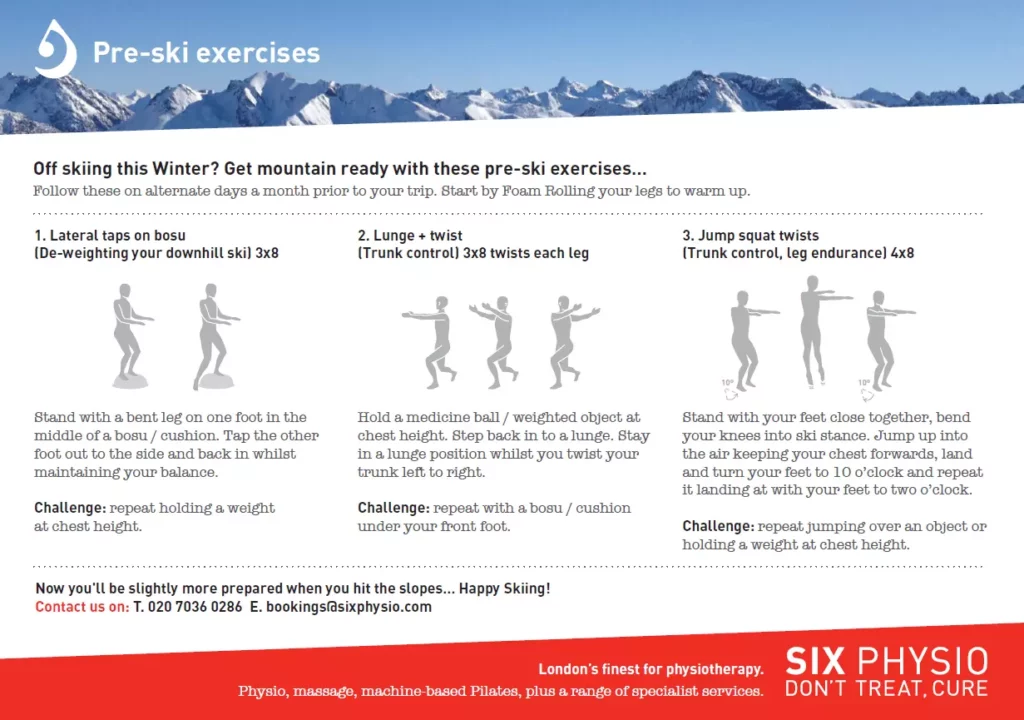Get ahead of the game and prepare your body for the rigour of the slopes By Sarah Bentley for Time & Leisure – Oonagh Turner Nov ’18
Ski season comes but once a year for most of us, so it’s unsurprising that by the time winter rolls around, our bodies aren’t at peak ski fitness. Skiing out of shape can increase the chance of injury, so if you’re feeling physically unprepared, your trip may be tinged with anxiety about what’s in store for you on the slopes. But with simple exercises and dedication, you’ll be flying down those red pistes or gentle blues with ease.
We get out of shape because skiing requires a unique body position which isn’t readily used throughout the year. And because the sport uses energy from your entire body, explains Sarah Bentley, rehab physiotherapist at Six Physio, Chelsea. “Skiing requires you to be in a semi-flexed position. For the rest of the year we do not train in a ski position. Therefore, it is important to train our muscles in ski positions to build up our endurance prior to hitting the slopes.”
Chris Myers, clinical director at Complete Physio, who has worked with members of the British ski and snowboarding team, adds that it’s this unaccustomed activity which is what the body struggles to cope with. It is often why injuries occur. “The correct preparation is the key to preventing many common aches, pains and injuries,” he says.
So ski fitness is easily lost, but it’s also relatively straightforward to get back to optimum level when the snowy slopes begin to beckon, but it does take dedication. “The harder you work before you go, the better you will feel on the slopes,” says Sarah. “This should involve some cardio, pilates-based strength and core control and balance work.” Sarah recommends ideally starting your training around 8-12 weeks before your intended outbound date.
Chris agrees, citing around three months of preparation time a good amount to increase muscle strength, but reminds us that this is case-by-case, and preparation may be different if you have sustained a previous injury. “If you have had previous injury, you are more likely to injure again compared with someone who has not, if so, we strongly advise you get it checked out by an experienced physio.”
The muscles we use most when skiing – and therefore the ones we need to focus on – include the core, which is crucial for maintaining balance and stabilising your pelvis and spine. Your gluteal complex is also one of the most essential and powerful muscles groups in skiing and also needs focus. These act as stabilisers around the hip and help with extension and external rotation of the leg, allowing the rotary movements you need to turn your skis and maintain a parallel position.
“Ski fitness is easily lost, but it’s also relatively straightforward to get back to optimum level when the snowy slopes begin to beckon, but it does take dedication.”
Leg muscles are also key, with the outer compartment of the lower leg controlling pressure on the outer foot enabling you to edge on your skis. The calf complex allows you to maintain and adjust to an optimal ski position, while the quads hold you in position and provide knee protection. Feet and ankles are also a crucial muscle group, responsible for edging, pressure and rotational movements. In the upper body, muscle strength is necessary for stabilising your spine, and arm muscles are needed when planting poles in the snow.
Dedicated classes dotted around London and Surrey cater for those keen to train these muscles throughout the year. Chel-ski is an indoor ski and snowboard facility in Chelsea that runs classes under the supervision of qualified instructors. Head instructor Daniel Crawford recommends their Fit-Ski classes as a way to focus training. The class comprises a 30 minute off-slope warm up and 30 minutes of on-slope exercise on skies.
Aside from opting for a class, Ski Fitness founder, Ollie Martin, also advises keeping active throughout the year by doing what you enjoy. “Mountain biking, gardening and hiking are just a few great ideas that make a difference.”
Sarah advises that simple exercises built into a daily routine can work wonders to build up strength:
“Try adding in 20 sit-to-stands from your desk before you go out to lunch and another 20 before you go home. Try walking to work instead of getting the bus or train.”
Ultimately, your ski holiday is a precious week that always flies by, so get started on your fitness regime, work on your core strength, and keep exercises up on a daily basis so as to enjoy every single second in the snow.
Pick up one of our Ski Exercise sheets if you’re passing…

